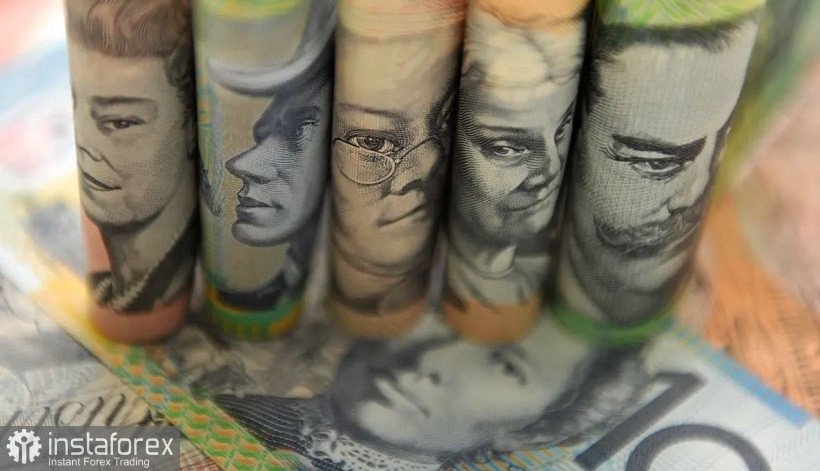The Australian dollar, paired with the US currency, is actively regaining lost positions: the aussie is taking advantage of the weakening of the general greenback. The AUD/USD pair has been declining for a month and a half - from early June to mid-July. And although the downward dynamics was accompanied by upward rollbacks, the downward trend clearly dominated. If last month the bears easily overcame the support level of 0.7000, which served as a reliable price outpost for many months. As a result, the aussie made a new two-year low, dropping to 0.6685. The last time the pair was at such bottoms was in July 2020, when strict quarantine restrictions were introduced in Australia.

To date, coronavirus remains a headache for Australians: the number of infected is growing again due to another mutation of the Omicron strain. But the market is already reacting differently to the coronavirus factor. Despite the COVID outbreak, the Australian authorities are in no hurry to increase quarantine restrictions or close megacities, as they did two years ago. The main focus is on vaccination in the context of receiving a booster dose of the anti-COVID vaccine. Therefore, market participants are effectively ignoring medical reports - at least Australian ones. AUD/USD traders are more worried about the spread of the coronavirus in China, as the PRC has a zero tolerance policy: due to a few identified cases, Beijing may quarantine, for example, a large metropolis (such as Shanghai), thereby destroying numerous supply chains.
By the way, data on the growth of the Chinese economy published on Friday put additional pressure on the aussie: the Shanghai lockdown and other quarantine restrictions did not go unnoticed for China. In the second quarter, China's GDP fell by 2.6% compared to the period of January-March this year. If in the third quarter the decline in the country's economy continues (which is very likely), then China will be in recession. As you know, China is one of Australia's main trading partners, so these results disappointed AUD/USD traders. Last week, bears were able to test the 66th figure for the first time in two years.
But they failed to settle in this price area, primarily because of the general weakening of the US currency. If at the end of last week the US dollar index was at the level of the 108th figure, then at the moment it has fallen to 106.80. Ahead of next week's July Federal Reserve meeting, dollar bulls raised their hawkish expectations too sharply, under the influence of the latest inflationary release (a record rise in the US consumer price index), as well as after the announcement of the results of the July meeting of the Bank of Canada (which unexpectedly increased the interest rate by 100 points at once). Rumors began to circulate on the market that the US central bank would go the same way, and at the next meeting. Here it is necessary to recall that quite recently Fed Chairman Jerome Powell said that at the July meeting the central bank would decide whether to raise the rate by 50 points or by 75. Moreover, after the release of the report on the growth of the core PCE (which again showed signs of slowdown), the scale began to gradually tilt in favor of a 50-point increase. Therefore, such a sharp swing in market sentiment allowed the dollar bulls to organize a small but victorious rally.
However, traders jumped to conclusions. Over the next few days, several representatives of the Fed (Waller, Bullard, Bostic, Daley) voiced their position - of which only Mary Daly supported the idea of a 100-point rate hike. Everyone else was skeptical about the implementation of this scenario. Another reversal in this issue had a negative impact on the greenback: dollar bulls were forced to retreat.
Actually, thanks to a kind of false start, the Australian dollar was able to win back part of the lost ground.
Additional support for the aussie can be provided by the minutes of the last meeting of the Reserve Bank of Australia, which will be published tomorrow, July 19. Let me remind you that at the July meeting the central bank raised the interest rate by 50 basis points. Despite such a hawkish decision, the Australian dollar reacted stolidly to this fact - primarily due to the fact that the central bank implemented a base, widely expected scenario, which was already priced into. In addition, the rhetoric of the central bank's accompanying statement, as well as RBA Governor Philip Lowe's comments, disappointed with their neutral tone. The probability of a 50-point advance in August has declined. Experts suggested that the rate of tightening of the monetary policy of the RBA in the second half of the year will slow down. The minutes of the July meeting can either confirm these assumptions or refute them.
In terms of technique, the pair is traded between the middle and lower lines of the Bollinger Bands indicator, as well as between the Tenkan-sen and Kijun-sen lines. This suggests that the situation is uncertain, although at the moment the likelihood of a resumption of the downward trend still prevails. Longs for the pair should be considered after bulls overcome the resistance level of 0.6880 (Kijun-sen line at D1). In this case, the price will be above the Tenkan-sen and Kijun-sen lines of the Ichimoku indicator, as well as between the middle and upper lines of the Bollinger Bands indicator (but below the Kumo cloud). Such a technical pattern will allow bulls to count on further price growth - to the upper line of the Bollinger Bands on D1, that is, to the main resistance level of 0.7000.
 English
English 
 Русский
Русский Bahasa Indonesia
Bahasa Indonesia Bahasa Malay
Bahasa Malay ไทย
ไทย Español
Español Deutsch
Deutsch Български
Български Français
Français Tiếng Việt
Tiếng Việt 中文
中文 বাংলা
বাংলা हिन्दी
हिन्दी Čeština
Čeština Українська
Українська Română
Română

